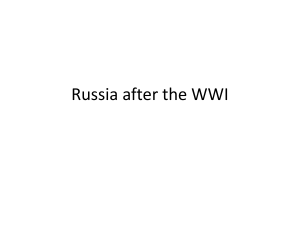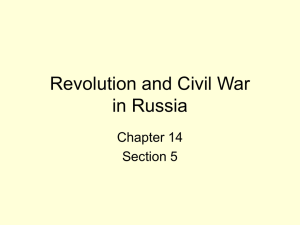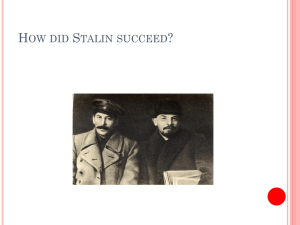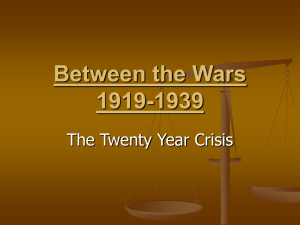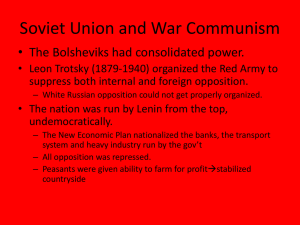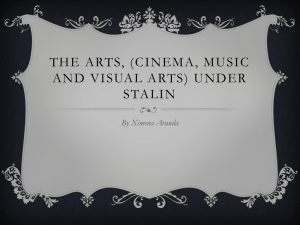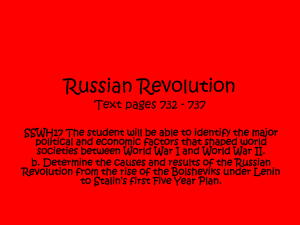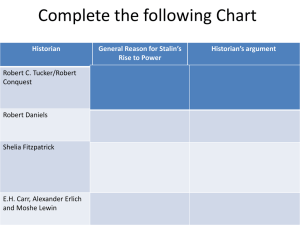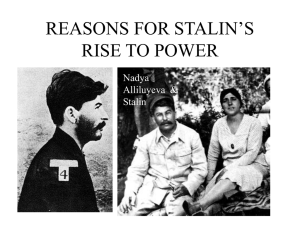The 1920s - bankstowntafehsc
advertisement
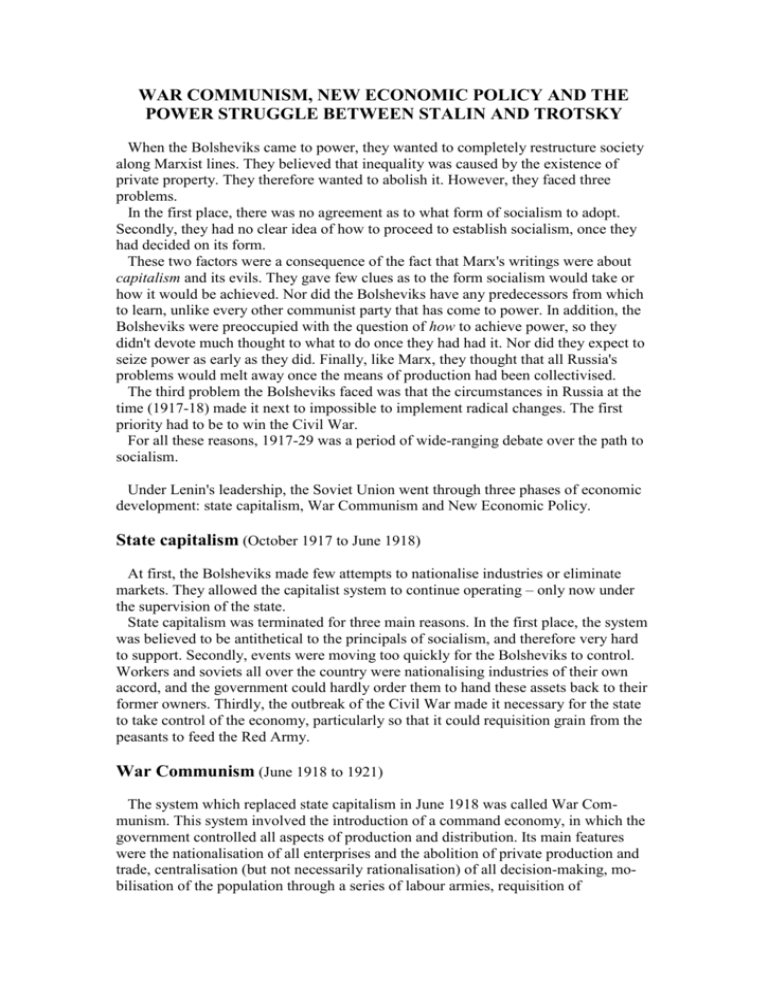
WAR COMMUNISM, NEW ECONOMIC POLICY AND THE POWER STRUGGLE BETWEEN STALIN AND TROTSKY When the Bolsheviks came to power, they wanted to completely restructure society along Marxist lines. They believed that inequality was caused by the existence of private property. They therefore wanted to abolish it. However, they faced three problems. In the first place, there was no agreement as to what form of socialism to adopt. Secondly, they had no clear idea of how to proceed to establish socialism, once they had decided on its form. These two factors were a consequence of the fact that Marx's writings were about capitalism and its evils. They gave few clues as to the form socialism would take or how it would be achieved. Nor did the Bolsheviks have any predecessors from which to learn, unlike every other communist party that has come to power. In addition, the Bolsheviks were preoccupied with the question of how to achieve power, so they didn't devote much thought to what to do once they had had it. Nor did they expect to seize power as early as they did. Finally, like Marx, they thought that all Russia's problems would melt away once the means of production had been collectivised. The third problem the Bolsheviks faced was that the circumstances in Russia at the time (1917-18) made it next to impossible to implement radical changes. The first priority had to be to win the Civil War. For all these reasons, 1917-29 was a period of wide-ranging debate over the path to socialism. Under Lenin's leadership, the Soviet Union went through three phases of economic development: state capitalism, War Communism and New Economic Policy. State capitalism (October 1917 to June 1918) At first, the Bolsheviks made few attempts to nationalise industries or eliminate markets. They allowed the capitalist system to continue operating – only now under the supervision of the state. State capitalism was terminated for three main reasons. In the first place, the system was believed to be antithetical to the principals of socialism, and therefore very hard to support. Secondly, events were moving too quickly for the Bolsheviks to control. Workers and soviets all over the country were nationalising industries of their own accord, and the government could hardly order them to hand these assets back to their former owners. Thirdly, the outbreak of the Civil War made it necessary for the state to take control of the economy, particularly so that it could requisition grain from the peasants to feed the Red Army. War Communism (June 1918 to 1921) The system which replaced state capitalism in June 1918 was called War Communism. This system involved the introduction of a command economy, in which the government controlled all aspects of production and distribution. Its main features were the nationalisation of all enterprises and the abolition of private production and trade, centralisation (but not necessarily rationalisation) of all decision-making, mobilisation of the population through a series of labour armies, requisition of agricultural produce from the peasants (by force, if necessary), universal rationing (via the Food Commissariat), temporary elimination of money (and its replacement by a system of barter) due to cripplingly high levels of inflation , and the outlawing of strikes. War Communism proved disastrous for the economy. Because most industrial output was required by the army, peasants could only be paid a pittance for their produce. As a result, many farmers refused to sell their produce to the state, selling it on the black market instead. The government responded by forcibly requisitioning agricultural goods, but the peasants reacted by cutting production altogether. By 1921, cereal production had fallen by 60 percent from its 1916 level, and livestock numbers had fallen by 70 percent. This resulted in a famine during the winter of 1921-22. Another problem the nation faced was a severe fuel shortage, which caused the transportation to all but collapse (by 1920, less than a quarter of Russia’s locomotives were still operating). When this was coupled with the blockade of Russia’s ports by Britain and France, it became very difficult to supply the nation’s factories with raw materials. As a result, by 1921 industrial production had sunk to only 20 percent of its 1913 level. Many people in the cities died from cold, disease and malnutrition, and many others fled to the countryside in the hope of saving their lives. War Communism was brought to an end in March 1921, for four main reasons. Firstly, the Civil War had ended, which eliminated the need for total control over resources. Secondly, there was an urgent need to increase production – both agricultural and industrial. This could not be done under a stop-gap system like War Communism. Thirdly, the workers had proven incapable of running industry efficiently – even when supplies of raw materials were made available. Finally, the economic collapse had caused widespread opposition to the Bolsheviks. This had to be dealt with by the use of terror, which had further alienated the population. The final straw came with the revolt of the Kronstadt garrison in March 1921. This was particularly worrying to the Bolsheviks because the sailors had been staunch supporters of the revolution up to that point. Now they were demanding political and economic reforms. Lenin ordered his troops to crush the revolt, and had its leaders shot. But he was realistic enough to know that economic reforms could not be postponed. New Economic Policy (1921-28) In March 1921, the Bolsheviks introduced their New Economic Policy (NEP), which essentially involved a mixed economy under state supervision. Under NEP, there was some central planning, but production was carried out in state, private and cooperative enterprises. The state retained the largest enterprises (and ran them according to market principles), but either privatised or leased out the rest (often to their original owners). In practice, this still meant that most industry was government owned, since 90 percent of Russian output was produced by large enterprises. Privately run enterprises paid rentals to the government (in the form of a fixed proportion of their output). The main thrust of NEP was to raise agricultural production, so peasants were given incentives to produce. They had to give 10 percent of their produce to the government, but could sell the rest on the market. Rich peasants (kulaks) were even allowed to hire labourers. Lenin's new slogan for Communist Party members was ‘Learn to trade’. NEP had two main consequences. Firstly, the economy began to recover, especially in the areas of agriculture and light industry. By 1925, agricultural production had returned to 1913 levels; and by 1928, GDP had reached its pre-Civil War level. (Industrial production rose less rapidly than agricultural production because most Russian industries were not subject to the NEP reforms; they remained government controlled.) Secondly, popular unrest declined, permitting a reduction in political repression. NEP was initially seen as a temporary retreat from socialism - a compromise necessary to repair the damage done to the economy by World War One, the two revolutions and the Civil War. But by the end of his life, Lenin had begun to see it as a valid route to socialism - an evolutionary path, necessary because Russia had not yet undergone its capitalist stage (which Marx and most of his disciples believed was essential before the transition to socialism could occur). Lenin’ demise In 1921, Lenin banned factions within the Communist Party, as a means of unifying the party following the Kronstadt rebellion in 1921. The following year, he appointed Stalin to the new position of General Secretary of the party. These two decisions had a lasting influence on Russia and the Communist Party, for they gave Stalin the tools he needed to eliminate his rivals and assume absolute power. Lenin had never tried to dictate to the members of the Politbureau, preferring to persuade then by logic or persistence. However, his influence diminished considerably following his first stroke in 1921. Lenin became increasingly suspicious of Stalin’s ‘bureaucratic’ behaviour, following the latter’s vendetta against his fellow communists in Georgia (Stalin’s home state). In December 1922, Lenin asked Trotsky to form a ‘counter-bureaucratic’ bloc to counter Stalin’s influence. Later that month, he suffered another stroke, and now devoted what little time he had available to writing what became known as his ‘testament’ – a critique of the communist Party leaders who might succeed him. His aim was to spare the party from a slide into bureaucratism and authoritarianism. He believed Trotsky was the most talented of his colleagues, although he warned of the man’s excessive self-confidence and his high-handedness. Most of his criticisms were reserved for Stalin whom he believed incapable of using power wisely. He also spoke highly of Bukharin, who he believed was a future leader. Of the other leaders, he had little to say. It seems Lenin believed no one was fit to succeed him at that time. The best hope was for a dual leadership under Trotsky and Stalin, with the others keeping watch on both of them. But Lenin must have realised that Stalin had concentrated so much power in his own hands that he would inevitably dominate the Politbureau in the years to come. As such, he proposed that Stalin be replaced as General Secretary with a man ‘more patient, more loyal, more courteous and more considerate of his comrades, less capricious’. By early March 1923, Lenin had become convinced of the need to remove Stalin from his post. But he never got to carry out his wish; the very next day he suffered a severe stroke, which left him half-paralysed and unable to speak. It would be left to others to determine who would succeed him as leader and which direction Russia would take in both the economic and political sphere. Problems with NEP Despite its initial success, NEP came under increasing criticism from 1924 onwards. There were four main reasons why this occurred. In the first place, although NEP had increased agricultural production, this increase was not fast enough for the Bolsheviks’ liking. This was because the redistribution of land had resulted in the dividing up of the larger landholdings – effectively returning much of the countryside to the inefficient form of production that had occurred before the 1905 Revolution. Although supporters of NEP assured the government that this would eventually change, the Bolsheviks wanted increased grain deliveries immediately, so that they could close the economic gap between Russia and the West. This could only be done by a build-up of heavy industry. The Bolsheviks also had ideological reasons to oppose NEP. Rapid industrialisation was seen as essential to create a large working class, and thereby bolster the Bolsheviks' power base. NEP promised only a slow development of Russia's industrial base, with equal emphasis on agriculture, consumer goods and heavy industry. There was also the problem of peasant attitudes. NEP was seen by many on the left wing of the party as reinforcing capitalism - especially in the countryside, where a class of wealthy peasants (Kulaks) was developing. These private farmers, the leftists argued, would never support the Bolsheviks or socialism. Lenin had realised that the Revolution could only survive if it maintained an alliance between the peasants and the workers. In his last years, he advocated the establishment of rural cooperatives, to achieve a form of socialism acceptable to the peasants. He was realistic enough to know that this policy would take a long time to succeed, but he warned his colleagues against using force to hasten the process. The industrialisation debate of the 1920s In the mid 1920s, a debate began on how Russia should achieve industrialisation. Everyone agreed that Russia needed capital, to finance investment. The most obvious sources were the international banks, but given those institutions' attitude to the Bolsheviks, foreign loans were not really an option. The only other source was domestic, and this meant generating an agricultural surplus. But this presented a serious dilemma. Such a surplus could be achieved by encouraging rural capitalism (via NEP), but this would weaken the Bolsheviks’ ideological support. It could also be achieved by collectivising the land, but this would require the socialist system to exploit the peasantry – the very thing the Bolsheviks opposed. Preobrazhensky’s view In 1924, E.A. Preobrazhensky published a paper entitled "The Fundamental Law of Socialist Accumulation" in which he argued that the socialist revolution in Russia was mis-timed, in that it had come before capitalism had built an industrial base by exploiting the working class. The Bolsheviks could therefore not distribute the nation's wealth according to the needs of the population because those needs were greater than the productive capacity of the economy. Preobrazhensky argued that the ‘primitive capitalist accumulation’ stage of development (which Marx believed was unavoidable) would have to be replaced by ‘primitive socialist accumulation’. The workers and peasants would have to be paid less than the value of their labour if a surplus was to be created which could finance industrialisation. And since the Russian economy was predominantly agrarian (agriculture accounting for 50 percent of GDP, compared to industry's 35 percent), the peasants would have to bear most of the burden of capital accumulation. Preobrazhensky's preferred method of surplus extraction was to pay the peasants artificially low prices for their produce, although he recognised that high taxes would serve the same purpose (even if at a higher political price). Bukharin’s view Preobrazhensky's position was strongly opposed by Nikolai Bukharin, Russia's leading economist at the time, who argued that NEP was the proper path to socialism. Bukharin did not believe that the Russian peasantry could be successfully exploited to the extent suggested by Preobrazhensky. The peasants would react to low prices or high taxes by reducing output, growing only enough food for their own consumption; hence, there would be no surplus for industrialisation. NEP, on the other hand, would encourage them to produce, by providing them with material incentives. Investment could then be financed through moderately progressive income tax and voluntary savings. Under the Bukharin plan, only the ‘commanding heights’ of the economy would be nationalised; the system would be one of market socialism, with small-scale capitalism permitted. Bukharin recognised that his plan would involve a much lower rate of investment and than Preobrazhensky's, however, he argued that the ensuing growth would be a more balanced and sustainable. This was because under NEP, there was no conflict between industrialisation and peasant prosperity. Indeed, the former was dependent upon the latter, since the peasantry would provide the demand for industrial goods. Finally, Bukharin recognised that there were important political reasons for opposing Preobrazhensky's plan. If exploited too heavily, the peasants might rise up in rebellion. NEP, on the other hand, would win them over to Bolshevism and strengthen the Party's hold on power. The power struggle between Stalin and Trotsky The industrialisation debate got caught up in the leadership struggle of the mid and late 1920s, particularly that between Stalin and Trotsky. During this conflict, Stalin did not need to follow some grand plan. All he had to do was stand back and watch his rivals destroy each other, joining forces with whichever side posed the smallest threat to his own ambitions. Stalin was the least intelligent of the Bolshevik leaders ("the most eminent mediocrity in the party", as Trotsky described him), but he possessed abilities which allowed him to rise high in the party structure. In particular, he was willing to do much of the tedious work the other leaders detested. As General Secretary, he was able to appoint his own proteges to many important positions, and thereby gain their support within the party. Hence he became a required ally in the disputes which split the Politbureau after Lenin's death. Trotsky, on the other hand, lacked Lenin's prestige, and hence had less influence over the party. His support base was among the soldiers, students and government workers. However, he was very unpopular in other sections of the party. The party officials disliked him because he opposed any increase in their power. The less educated workers also disliked him, because they saw him as an arrogant intellectual. Many of these men had joined the party as a means of securing employment, and were little interested in politics. As such they were easily controlled by party organisers, most of whom had been appointed by Stalin. Such men were simply unable to understand the arguments put forward by Trotsky. (It was to prevent such a development that Lenin had chosen to limit party membership to the better educated and more committed workers.) Trotsky had his best chance to discredit Stalin by attacking him on the grounds of his dictatorial behaviour in Georgia - something Lenin had implored him to do. But Trotsky chose not to exploit this opportunity. Nor did he use Lenin's 'testament' to discredit Stalin, instead agreeing to keep the document hidden from those outside the Politbureau. The reason he later gave was that he was unwilling to split the party by forming an opposition bloc, particularly since Kamenev and Zinoviev were siding with Stalin. This decision, more than anything, contributed to his downfall. Stalin had no such reservations about attacking his enemies. During the so-called ‘scissors crisis’ of 1923 (when the price of agricultural goods fell and that of industrial goods rose, leaving the peasants little incentive to produce), Stalin sided with Kamenev and Zinoviev (the so-called troika), arguing that priority should be given to generating a recovery in the agricultural sector (the Bukharin view). Trotsky, as leader of the ‘left opposition’, advocated Preobrazhenski view – that the peasants should be squeezed to finance rapid industrial development (thereby strengthening the working class). Stalin used his influence in the party machine to win the debate; Trotsky was isolated. The conflict between the two men now turned to matters of ideology. Trotsky was concerned that the Communist Party was becoming undemocratic, stifling internal debate and denying members the right to select their representatives to the Party Congress and the Central Committee. It was Lenin who had banned factions, as a means of unifying the party following the Kronstadt rebellion in 1921. Now Stalin used this policy to attack Trotsky, accusing him of factionalism. The second of Trotsky’s concerns was that the Bolshevik regime could not survive in isolation, because Russia needed help to industrialise. This help would only be forthcoming from other socialist countries, but that necessitated the spread of revolution. Moreover, Trotsky feared that if Russia did not industrialise quickly, it faced the prospect of attack from the capitalist world. Trotsky’s answer was to offer support to communist movements in the advanced, capitalist nations, in the hope the Bolshevik Revolution would act as a trigger for uprisings there (this was his theory of ‘permanent revolution’). Stalin rejected Trotsky’s reasoning, arguing that Russia could survive perfectly well on its own – a policy he called ‘socialism in one country’. He accused Trotsky and his supporters of lacking faith in the revolution and the Russian working class. Stalin won out over Trotsky. At the fourteenth party congress in 1925, the concept of ‘socialism in one country’ was endorsed, winning Stalin considerable support within the party. Trotsky was forced to resign as Commissar for War. Stalin’s consolidation of power With Trotsky’s influence reduced in the Politbureau, Zinoviev and Kamenev now feared Stalin’s power. They tried to use the industrialisation debate as a means of discrediting Stalin, arguing that NEP would lead to the restoration of capitalism. This was a reversal of the right wing line they had taken during the ‘scissors crisis’, and was little more than a political ploy. Stalin retorted that it would take many years for the peasants to accept the need for collectivisation, so NEP needed to be maintained. He and his principal ally, Nikolai Bukharin, won the debate. As a result, the influence of Zinoviev and Kamenev was reduced. Soon after, Stalin succeeded in having three of his allies (Molotov, Kalinin and Voroshilov) added to the Politbureau. Kamenev and Zinoviev now formed an alliance with Trotsky. They attacked Stalin on the grounds of foreign policy mistakes Russia had made in 1926 (failing to offer support to the workers staging a general strike in Britain, and failing to help the Chinese communists against Chiang Kai-shek’s forces during the Shanghai massacres). Stalin accused the three leaders of attempting to destroy party unity, and had them expelled from the Politbureau. In 1927, he had them expelled from the party. Zinoviev and Kamenev were later readmitted, after they had acknowledged their mistakes, but Trotsky held firm. In 1928 he was kidnapped and deported to Soviet Central Asia. (Kamenev and Zinoviev were executed in 1936.) The end of NEP With his left wing critics now silenced, Stalin now turned on his right wing allies – Bukharin (the editor of Pravda), Tomsky (the leader of the trade union movement) and Rykov (the Chairman of Council of People’ Commissars). He attacked them over the NEP, which he said was encouraging a return to capitalism – the very line Trotsky, Kamenev and Zinoviev had taken prior to their expulsion from the party. The peasants, he suggested, were reactionaries, who would never support the Bolsheviks unless divested of their private property. Stalin also agreed with Preobrazhensky's view of the need for primitive accumulation, but also with Bukharin's view that the peasants might react to high taxes by reducing production. As such, he concluded that the peasants would have to be made to produce by being organised together into collectives. These he believed would be highly efficient, since they could utilise the machinery produced by heavy industry. They would also allow him to increase state power over the population – which, of course, would increase his own personal power. As such, Stalin proposed to eliminate virtually all market forces and private enterprise from the Soviet economy. The USSR would become the world's first command socialist economy, run by a vast bureaucracy based in Moscow. The problem of how to appropriate agricultural surplus would be solved by means of mass collectivisation (something even Preobrazhensky had stopped short of recommending). The peasantry would be induced to produce under threat of death. This surplus would then the ploughed into heavy industry, which would develop rapidly. Stalin used his influence in the party to secure the votes he needed to get his way. In April 1929, the right wing was defeated, and Bukharin, Tomsky and Rykov were dismissed from the Politbureau. (All three were killed by Stalin in the 1930s.) Trotsky was stripped of his citizenship and deported to Turkey.

